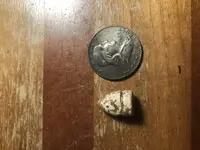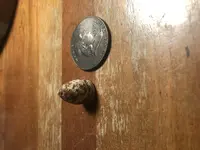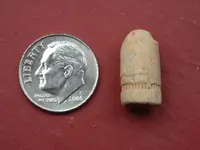You are using an out of date browser. It may not display this or other websites correctly.
You should upgrade or use an alternative browser.
You should upgrade or use an alternative browser.
Help with bullet ID
- Thread starter Fossils
- Start date
- Joined
- Mar 5, 2010
- Messages
- 7,639
- Reaction score
- 12,322
- Golden Thread
- 0
- Location
- Southwest Georgia
- Detector(s) used
- XP Deus, White's DFX
- Primary Interest:
- All Treasure Hunting
When I enlarge the picture I can clearly see the ridges in the groove. Accurate measurements would be a great help in IDing your bullet. The ridges date the button no earlier than circa 1870.
Upvote
0
pistol-pete
Hero Member
- Joined
- Nov 4, 2012
- Messages
- 632
- Reaction score
- 728
- Golden Thread
- 0
- Location
- Custer County, CO. at 9300 Ft.
- Detector(s) used
- 1970 Garrett Hunter, Garrett Ace 350, Garrett AT Gold, Garrett pinpointer
- Primary Interest:
- Metal Detecting
We don't use the metric system in America. What size in Thousands of an inch
Upvote
0
Tibodoe
Jr. Member
- Joined
- Jan 7, 2021
- Messages
- 37
- Reaction score
- 85
- Golden Thread
- 0
- Location
- Baton Rouge, Louisiana
- Detector(s) used
- XP Deus
Tesoro Silver Saber
Fisher 1270
- Primary Interest:
- Relic Hunting
13mm=.512We don't use the metric system in America. What size in Thousands of an inch
Upvote
0
TheCannonballGuy
Gold Member
- Joined
- Feb 24, 2006
- Messages
- 6,606
- Reaction score
- 13,441
- Golden Thread
- 0
- Location
- Occupied CSA (Richmond VA)
- Detector(s) used
- White's 6000, Nautilus DMC-1, Minelab
- Primary Interest:
- Relic Hunting
I've deliberately delayed responding about your bullet, in the hope that somebody else could provide 100%-certain ID for it. At this point, it looks like that's not going to happen, so here's my reply.
You asked:
> Yeah, there are small ridges in the groove. Does anyone know what these ridges are called?
In bullet-collector lingo, the groove (it is not a "ring") which encircles the bullet's main body is called a cannelure. The tiny multiple parallel ridges inside the groove are called "reeding" -- which is what you see on the edge of some American coins. Thus, what we see on your bullet is called a "reeded cannelure" although some people call it a "knurled cannelure." See the example of it in the photo below, which shows a .32 pistol bullet from the early1900s.
Bullets with a reeeded cannelure are ALWAYS machine-made, never cast in a bulletmold.
As a civil war relic digger and dealer for over 40 years, I've closely studied "historical" (pre-20th-Century) American bullets. The earliest date my research has turned up so far for a reeded cannelure/groove on an American bullet is 1877.
Now, about your bullet's identification:
When you were asked to tell us its precisely-measure diameter (in thousandths of an inch), you repeated that it is 13mm, which translates to .512-inch. That precise diameter is correct for a .50-caliber breechloading firearm bullet. (A 13mm-caliber bullet is actually a bit larger than .512-inch.)
As a .50-caliber, your bullet's body is too short to function properly as a rifle bullet. Therefore, it must have been made for use in a .50 pistol.
Your excavated bullet shows the typical greyish-white patina we civil war bullet diggers commonly see on PURE LEAD bullets from that era. Being made of pure-lead instead of post-civil-war-to-today "hardened-lead" alloy, AND being a machine-made bullet, indicates your bullet was manufactured sometime between 1877 and about 1890. (I said "indicates" because there are always a few exceptions to any rule.)
In trying to deduce your bullet's correct identification, we must include the fact that you dug it in the US, not in Europe or elsewhere... so, it is most probably American-made.
Considering all of the factors listed above, I believe the "most likely candidate" identification for your bullet is that it was made for use in a .50 Remington 1871 US Army Rolling Block single-shot pistol.
https://americanhistory.si.edu/collections/search/object/nmah_438555
You asked:
> Yeah, there are small ridges in the groove. Does anyone know what these ridges are called?
In bullet-collector lingo, the groove (it is not a "ring") which encircles the bullet's main body is called a cannelure. The tiny multiple parallel ridges inside the groove are called "reeding" -- which is what you see on the edge of some American coins. Thus, what we see on your bullet is called a "reeded cannelure" although some people call it a "knurled cannelure." See the example of it in the photo below, which shows a .32 pistol bullet from the early1900s.
Bullets with a reeeded cannelure are ALWAYS machine-made, never cast in a bulletmold.
As a civil war relic digger and dealer for over 40 years, I've closely studied "historical" (pre-20th-Century) American bullets. The earliest date my research has turned up so far for a reeded cannelure/groove on an American bullet is 1877.
Now, about your bullet's identification:
When you were asked to tell us its precisely-measure diameter (in thousandths of an inch), you repeated that it is 13mm, which translates to .512-inch. That precise diameter is correct for a .50-caliber breechloading firearm bullet. (A 13mm-caliber bullet is actually a bit larger than .512-inch.)
As a .50-caliber, your bullet's body is too short to function properly as a rifle bullet. Therefore, it must have been made for use in a .50 pistol.
Your excavated bullet shows the typical greyish-white patina we civil war bullet diggers commonly see on PURE LEAD bullets from that era. Being made of pure-lead instead of post-civil-war-to-today "hardened-lead" alloy, AND being a machine-made bullet, indicates your bullet was manufactured sometime between 1877 and about 1890. (I said "indicates" because there are always a few exceptions to any rule.)
In trying to deduce your bullet's correct identification, we must include the fact that you dug it in the US, not in Europe or elsewhere... so, it is most probably American-made.
Considering all of the factors listed above, I believe the "most likely candidate" identification for your bullet is that it was made for use in a .50 Remington 1871 US Army Rolling Block single-shot pistol.
https://americanhistory.si.edu/collections/search/object/nmah_438555
Attachments
Last edited:
Upvote
0
Fossils
Full Member
- #9
Thread Owner
I've deliberately delayed responding about your bullet, in the hope that somebody else could provide 100%-certain ID for it. At this point, it looks like that's not going to happen, so here's my reply.
You asked:
> Yeah, there are small ridges in the groove. Does anyone know what these ridges are called?
In bullet-collector lingo, the groove (it is not a "ring") which encircles the bullet's main body is called a cannelure. The tiny multiple parallel ridges inside the groove are called "reeding" -- which is what you see on the edge of some American coins. Thus, what we see on your bullet is called a "reeded cannelure" although some people call it a "knurled cannelure." See the example of it in the photo below, which shows a .32 pistol bullet from the early1900s.
Bullets with a reeeded cannelure are ALWAYS machine-made, never cast in a bulletmold.
As a civil war relic digger and dealer for over 40 years, I've closely studied "historical" (pre-20th-Century) American bullets. The earliest date my research has turned up so far for a reeded cannelure/groove on an American bullet is 1877.
Now, about your bullet's identification:
When you were asked to tell us its precisely-measure diameter (in thousandths of an inch), you repeated that it is 13mm, which translates to .512-inch. That precise diameter is correct for a .50-caliber breechloading firearm bullet. (A 13mm-caliber bullet is actually a bit larger than .512-inch.)
As a .50-caliber, your bullet's body is too short to function properly as a rifle bullet. Therefore, it must have been made for use in a .50 pistol.
Your excavated bullet shows the typical greyish-white patina we civil war bullet diggers commonly see on PURE LEAD bullets from that era. Being made of pure-lead instead of post-civil-war-to-today "hardened-lead" alloy, AND being a machine-made bullet, indicates your bullet was manufactured sometime between 1877 and about 1890. (I said "indicates" because there are always a few exceptions to any rule.)
In trying to deduce your bullet's correct identification, we must include the fact that you dug it in the US, not in Europe or elsewhere... so, it is most probably American-made.
Considering all of the factors listed above, I believe the "most likely candidate" identification for your bullet is that it was made for use in a .50 Remington 1871 US Army Rolling Block single-shot pistol.
https://americanhistory.si.edu/collections/search/object/nmah_438555
Thank you very much for your reply! Your depth of knowledge is certainly a real treasure to this forum.
1870s-1890s makes a lot of sense, as I had found several IHPs of the same time period in the area.
Upvote
0
Similar threads
- Replies
- 4
- Views
- 431
- Replies
- 18
- Views
- 2K
Users who are viewing this thread
Total: 1 (members: 0, guests: 1)






